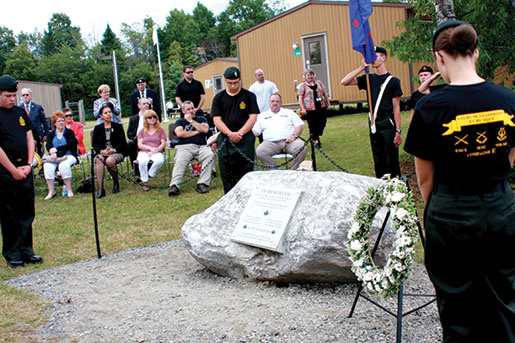The Valcartier grenade accident

Wreaths are placed near a memorial rock where a plaque names the cadets who died in the 1974 explosion. [SHARON ADAMS]
There was one green grenade in the box, but everyone assumed it was safe. No one knew that blue demonstration grenades had been transported with some live grenades, and that a live grenade had been placed in the demo box.
It ended up in the hands of 14-year-old Eric Lloyd, who pulled the pin. He and five other cadets were killed and more than 50 others wounded.
The Wegner Point disaster

A modern day search and rescue team practice a parachute training exercise. [Cpl Justin Ancelin, 17 Wing Imaging]
On the evening of May 8, 1968, 22 of the paratroopers were caught by sharp winds and blown away from their target of Mattawa Plains and into the cold waters of the Ottawa River near Wegner Point. Tangled and weighed down, the men struggled to stay afloat, some roughly 300 meters offshore.
Rescuers were quickly on the scene, but were unable to save all the men. Seven of the paratroopers lost their lives that night.
The Tarnak Farm incident

BARKSDALE AIR FORCE BASE, La. — Maj. Harry Schmidt and wife Lisa enter the Tarnak Farms Article 32 hearing room. [Photo by Master Sgt. Michael A. Kaplan]
Confusing the training exercise with what he believed to be hostile surface-to-air fire, Schmidt asked permission to open fire but was denied by the pilots’ Airborne Warning and Control System controller, who instructed them to “hold fire” and “make sure that it’s not friendlies”.
Shortly after this, Schmidt reported seeing another shot being fired from the Canadian anti-tank weapon and said, “I am rolling in in self-defense,” before dropping his bombs on the target in question.
After reporting a direct hit, Schmidt said “I hope I did the right thing,” before being informed by the AWACS controller that the target was, in fact, friendly.
Eight members of the 3rd Battalion, Princess Patricia’s Canadian Light Infantry Battle Group were injured, and four were killed: Sgt. Marc D. Léger, Cpl. Ainsworth Dyer, Pte. Richard Green and Pte. Nathan Lloyd Smith.
Advertisement





















